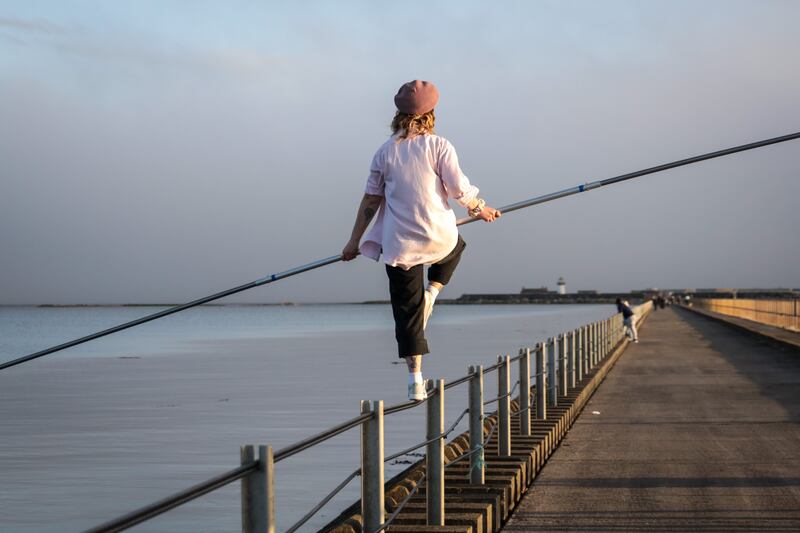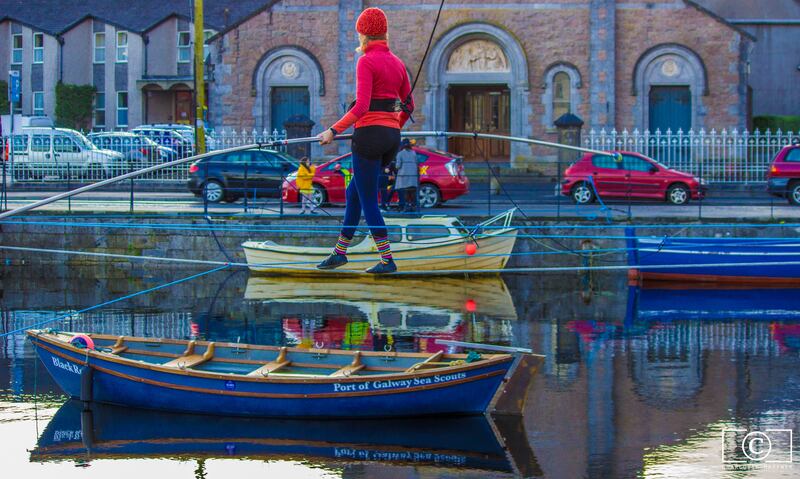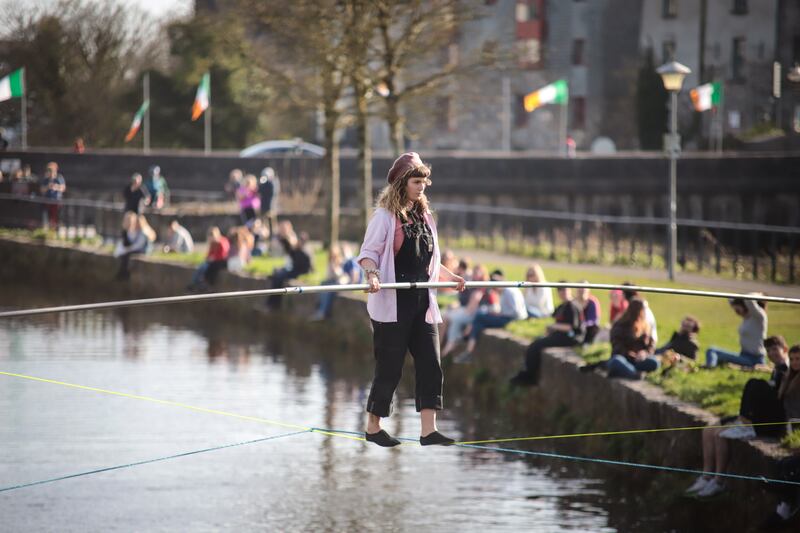It is a Saturday morning in Shantalla park, a green space that runs alongside a busy road in Galway. A young man with knotted dreadlocks and a bright-blue T-shirt is hovering a metre above the ground. With perfect posture and a distant gaze, he holds a metal pole at chest level in front of him and steps, one foot after another, one foot after another, into empty space. From a distance it looks as if he is walking through the air. Up close, a thin cable becomes visible, but the feat remains impressive, as the taut wire wobbles and settles with each tentative step and the cars whizz noisily by.
Shantalla park is the home of the Irish Centre of Funambulism, an offshoot of the Wires Crossed project, established by Galway Community Circus in 2016 as part of the Galway 2020 celebrations. Wires Crossed was dreamed up by the organisation as a response to the city’s high suicide rate.
“It seemed very bad in 2016,” says Ulla Hokkanen, director of Galway Community Circus. “Several men in the area died by suicide in the River Corrib. I was living beside it, and it was constant. Every week there was another death. You would hear the helicopters, and everyone who lives in Galway knows what that means: that someone has jumped into the river and the helicopters are looking for them.” In a community ravaged by grief, “everybody was asking the same thing: ‘What can we do about the river?’”


At the time, Galway Community Circus was looking for a project to contribute to the 2020 celebrations. “Because of all the suicide,” Hokkannen says, “we thought about this idea of trying to address youth mental health and wellbeing through circus. We are not trained mental-health experts, but with community projects like circus we can help create a preventive space, a safe space, for young people to overcome challenges and support themselves and each other.”
READ MORE
Hokkanen had recently returned from a European conference where she had been given the opportunity to try funambulism — the art of wire walking — for the first time, and she thought it would provide novices with a brilliant opportunity to develop a new skill, have fun, and use proactive mental-health tools. Funambulism, she says, is a very measurable skill. People “can see so easily their progression, whether you are talking about length of the walk, or height of the wire, or tricks you can do. It is easy for every single person to set their next objective — ‘I want to get to the other side’ or ‘I need to remember to breathe’ or ‘I want to be less nervous’ or ‘I want to do a headstand on a wire’. There is so much variety in terms of what you can do, the goal you want to set.”
Speaking of her own first encounter with the wire, she says, “I still remember the wires were this low” — she gestures to a few centimetres above the ground — “but the feeling to discover that I could do it, that spark, it was transformative.”


Hokkanen also saw funambulism as an opportunity to redefine the landscape of the city by framing the Corrib in a different light. The idea for a tightrope walk across the river began to take shape, a symbolic and literal reinvention of the “suicide hotspot” as a site of grief to a site of creativity and celebration.
The pandemic stopped the original large-scale performance piece planned as part of Wires Crossed from coming to fruition, but Galway Community Circus has been running a follow-up project, LifeLine, since 2020, and it will culminate in a spectacular performance — Europe’s largest highwire performance event — over the River Corrib on July 16th as part of Galway International Arts Festival.
Despite the aesthetic simplicity, funambulism requires a complex combination of physical and mental stamina. It requires focus, confidence and courage, the same tools used to manage fear, anxiety and self-doubt. Tony Mahon, who has worked as an artist and educator with Galway Community Circus for almost a decade, says the “pure physical stillness and balance involved” in funambulism distinguish it among the circus arts. Doing it involves what we often call mindfulness techniques, he says. “You need to listen to yourself and find a place of stillness in your mind.”
Before starting on the wires, Mahon explains, “your mind might be racing thinking ‘I can’t do it’, ‘I might hurt myself’, but once you are up on the wire you get gripped by the activity, the mission, the objective”. If you are going to succeed “you need to calm yourself, quiet the internal dialogue. You need to fight and centre yourself. It is not that easy at the start to get into that flow state, but with time you are able to shut off everything and you are walking on air. There is something about being off the ground, in space, that brings you to another place in your head. It is the buzz of doing it that gets you from one side to the other.”


Mahon has been involved with Galway Community Circus’s wire-walking project since the beginning, training new participants to get up on the wires. “The thing is,” he says, “people don’t believe they can be the superhero. ‘Nobody really does that,’ they’ll think. ‘That’s just something for television’, but they take the first few baby steps and they believe they can do it. Then they start to go to that crazy place where they make it to the end. It can be a really big journey for them.” When we are children “we believe we can do anything, but as we get older we get slower, more conditioned. You can lose the magic of believing in yourself, and it is really nice to genuinely empower people. And it is a good life lesson: with a bit of focus and determination, you can get a better balance in day to day life too.”
There is scientific evidence that confirms what Mahon calls the “mental and physical wellbeing” that funambulism promotes. At a conference organised by Galway Community Circus in July last year, researchers from the Université Libre de Bruxelles demonstrated the neurological effects of wire-walking on the brain, where action, skill and challenge produce what is known as a state of flow. In positive psychology, this state is characterised by a feeling of concentration, full involvement and pleasure. Funambulism, with its physical and psychological challenge, is regarded as an optimum activity for placing the central nervous system into the flow state.


Naomhan Joyce got involved as a teenager, and his experience attests to the transformative impact that involvement with the LifeLine project has had on his mental and physical health. Attending an all-boys school in the city, he struggled with anxiety and the athletic focus of his peer groups. “I wasn’t a particularly sporty kid,” he says, “and I didn’t have an outlet. I was really lucky to find circus, to come into a space that is so supportive and noncompetitive but that provides you with an outlet for physical activity. When I started I was so unfit and unflexible, but I picked the hardest thing to do as my speciality.
“When I started I couldn’t even get up on the equipment, but there was something about being awful at something and knowing the only thing you can do is get better. It really improved my mental health and outlook. Crossing the basin” — Claddagh Basin, at the mouth of the Corrib — was one of the most empowering experiences of my life, and to be from Galway and doing it in Galway, across the river, with all its grim connotations, to be subverting that, was an incredible feeling.”
Joyce will complete the feat again in the LifeLine showcase on July 16th, with more than 150 other participants, who will walk seven highwires: six strung above Claddagh Basin, one strung above the river. The ensemble is made up of international professionals from Europe and community participants from all backgrounds across the island of Ireland, whom Galway Community Circus recruited through partnership programmes with groups such as Jigsaw, the national organisation for youth mental health.


Hokkanen says the seemingly perilous extremity of the walk has attracted a variety of different people to the project. For some “the once-in-a-lifetime thing sounds like something inspiring and crazy: ‘I want to set myself a personal challenge.’ There is excitement and fear for those people who like the thrill and adventure of it.”
Others, she says, “have come across similar activities and understand the mindfulness and wellbeing aspect of it. They think, ‘that’s an activity that would be good for me’. They want to take it up as a hobby because they know it is about confidence building, that it’s uplifting.”
For a final group of participants, “they have a personal relationship with the river and the worry that is there, and they want to help us change the discourse around it”.
Hokkannen has already seen the narrative of the Corrib begin to change through their work, and she hopes that the performance on July 16th will continue to help Galway residents reconsider the river. “Whenever there is another suicide there is the debate again: ‘What should we do?’ Should there be safety barriers along the river, or nets across the basin? They are the physical safety measures, but you have to think long term; you have to address things like mental health service provision. It is about much more than the safety of a location.”
LifeLine, she concludes, shows that “safety can come from within, and from within a community”. When the walkers step on to the wires above the Claddagh Basin they become a “symbol for hope and resilience and overcoming challenges in life, with the support of community and the strength we have within. They will see the River Corrib in a different light, [see] that it is not just a place of negativity or tragedy, it can be a place of community and celebration, and art as well.”
LifeLine is at Claddagh Basin as part of Galway International Arts Festival on Saturday, July 16th, 1.20pm-6.30pm
Samaritans’ free helpline is at 116123, or you can email jo@samaritans.ie or jo@samaritans.org; Pieta’s free helpline is at 1800-247247, or text help to 51444



















